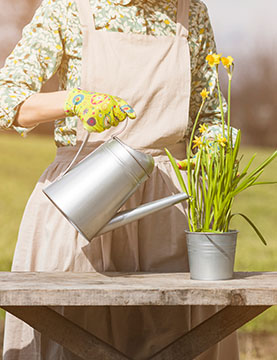A Passion for Parsley
Often when people walk around my Charleston garden they comment on the beautiful Queen Anne’s Lace and ask how I get it to grow so big. I just smile and tell them, “that’s not Queen Anne’s Lace, it’s parsley.”

Parsley flowers can get huge if given the opportunity to grow a second year. As a biennial, parsley produces edible leaves the first year and sets flowers and seeds the second year. After seeding, the original plant dies and new babies sprout up around it. Seeds are easily collected for resowing. Simply cut the stalk a few inches below the seed head and hang upside a few days in order to dry. To harvest seed heads, first run a finger over the seed head and notice how easily seeds fall off. If you have to work at it, wait a few days and retest. Seeds are usually ready in a medium gray-brown color stage. If left on the plant, seeds will naturally drop off and grow new plants the following year.
While most people add a few parsley plants to their herb gardens, the latest trend is to scatter them among pollinator plants as the perfect host plant. Parsley provides an upright medium-green filler to your flowers and the leaves serve as a larval host for twenty species of caterpillars including the swallowtail butterfly. In bloom, parsley flowers provide nectar to bees, flies, wasps, smaller beetles, as well as skipper and hairstreak butterflies.
In the vegetable garden, parsley makes an excellent companion plant to brassicas, beans, tomatoes and asparagus but gardeners should avoid planting it next to carrots or onions.
While many treat parsley simply as a garnish, fine chefs use parsley in almost everything. Like salt, parsley enhances the flavors of other herbs and spices. When combined with thyme, chervil, and other herbs it becomes the base of Bouquet Garni. Added to cream sauce, it creates the classic English Parsley Sauce served over fish or chicken. In Latin dishes, parsley is combined with garlic and other spices to create Salsa Verde.
All parts of the parsley plant are edible. Leaves can be consumed raw, dried or cooked. Stalks, roots, and leaves can be added to stock. Flowers and seeds can be sprinkled over salads or added to bread for added flavor.
Nutritionally, parsley is considered a superfood. (1)
Here’s why:
- Parsley has more vitamin C per ounce than lemons, oranges or any other fruit
- It also supplies Vitamins A, B, E, K, Beta-Carotene, Magnesium, Phosphorus, Manganese, Sodium, Potassium and Calcium
- Research has shown that parsley aids digestion and stimulates the appetite.
- Parsley neutralizes strong odors like garlic and onion.
- Parsley flavonoids and antioxidants stimulate the liver, spleen and endocrine organs.
While there are many cultivated varieties of parsley, three species are most commonly found in garden centers and seed catalogues. Each has its own unique flavors:

French, curly-leaf parsley (Petroselinum crispum var. crispum) has a mild flavor and is used most often as a breath freshening garnish or coursely chopped raw in salads. The reason it is so often used as a garnish is because it helps curb bloating and indigestion after a rich meal. Curly parsley has a more mild flavor than Italian so use more in recipes than the flat leaf species.

Italian, flat-leaf parsley (Petroselinum crispum var. neapolitanum) has a bolder flavor and is used most often in cooked dishes or sauces.
Try adding a 1/4 cup each of fresh parsley and fresh oregano to the ricotta cheese in your next lasagna. You’ll thank me!

Hamburg, root parsley, (Petroselinum crispum var. tuberosum) is grown in colder regions for its edible root, eaten much like a carrot. Often sliced with skin on and cooked, it lends a nutty, earthy parsley taste to soups and stews. Its leaves can also be eaten.
Although it resembles parsnips, their tastes are very different. I love to boil one or two roots with potatoes, then mash them together.
Parsley can be direct sown in early spring to late autumn in Zones 8-11 where it will easily overwinter and bloom the next spring. For zones 2-7, it is best sown in autumn for spring sprouting or after the last frost in early spring for summer harvest.
To dry parsley, you can place individual leaves in a slow oven for 20-30 minutes then allow to air dry the rest of the way or set them in a dehydrator on very low for 4-6 hours. If you want to skip these steps, simply hang a bundle upside down in a dry location out of direct sunlight. Once fully dried, they can be placed in jars with a desiccant packet to be used over the next 6 months or so.
To save parsley seeds, cut the stalks about 8-10” below the head and bundle together. Hang upside down over a screen or bowl to catch the seeds as they drop. Another method is to simply run your thumb over the seed head set over a catching bowl. Make sure seeds are grayish brown. Mature seeds will easily release. Store these is glass jars with desiccant or seed (coin) envelopes.
References:
(1) https://fdc.nal.usda.gov/fdc-app.html#/food-details/170416/nutrients

 Member Login
Member Login






